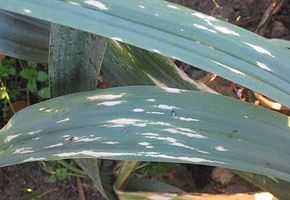Stramenopiles
|
|
Cet article est une ébauche concernant les protistes et les algues. Vous pouvez partager vos connaissances en l’améliorant (comment ?) selon les recommandations des projets correspondants.
|

Phytophthora porri sur une feuille
de poireau (Allium porrum)
| Domaine | Eukaryota |
|---|
Stramenopiles
(D.J.Patt., 1989)
Synonymes
- Straminopiles (forme corrigée)
- Stramenopila E.E.Ruppert et al., 2004
- Heterokonta Cav.-Sm., 1986
Taxons de rang inférieur
- Voir texte
- Eukaryota
- Unikonta
- Amoebozoa
- Opisthokonta
- Holomycota
- Nucleariida
- Fungi
- Holozoa
- Mesomycetozoa
- Filozoa
- Filasterea
- Choanobionta
- Holomycota
- Bikonta
- Apusozoa
- Excavata
- Metamonada
- Euglenozoa
- Percolozoa
- Plantae
- Chromalveolata s.l.
- Hacrobia
- Cryptophyta
- Haptophyta
- « SAR »
- Hacrobia
- Unikonta
Les straménopiles (en latin Stramenopiles, du latin stramen, straminis, et pilus : organismes à « pelage » en forme de « feuillage ») ou hétérocontes (Heterokonta[1] : « à flagelles différents ») constituent un infra-règne des eucaryotes.
Ils sont caractérisés par l'existence, au cours de leur cycle, d'une cellule biflagellée avec deux flagelles différents : un flagelle lisse et un flagelle plumeux à mastigonèmes tubulaires tripartites.
Seuls les Ochrophyta sont photosynthétiques ce qui explique qu'ils étaient autrefois classés parmi les algues. Les lignées ayant divergé le plus anciennement, comme les oomycètes, étaient autrefois classées comme champignons et d'autres encore étaient classées dans les protistes.
Taxons de rang inférieur
- Groupes hétérotrophes
- Blastocystae
- Proteromonadea
- Opalinidea
- Bicoecea
- Labyrinthulomycetes
- Oomycetes
- Hyphochytridiomycetes
- Bigyromonadea
- Groupes autotrophes (Heterokontophyta ou Ochrophyta)
- Pinguiophyceae
- Bacillariophyta
- Bolidophyceae
- Parmophyceae
- Pelagophyceae s.l.
- Pedillenophyceae s.l.
- Raphidophyceae
- Phaeothamniophyceae
- Chrysomerophyceae
- Xanthophyceae
- Schizocladiophyceae
- Phaeophyceae
- Eustigmatophyceae
- Chrysophyceae
Étymologie
L'origine du terme straménopile est explicitée dans le passage suivant d’Adl et al. (2005)[2] :
"Regarding the spelling of stramenopile, it was originally spelled stramenopile. The Latin word for ‘‘straw’’ is stramine-us, -a, -um, adj. [stramen], made of straw—thus, it should have been spelled straminopile. However, Patterson (1989)[3] clearly stated that this is a common name (hence, lower case, not capitalized) and as a common name, it can be spelled as Patterson chooses. If he had stipulated that the name was a formal name, governed by rules of nomenclature, then his spelling would have been an orthogonal mutation and one would simply correct the spelling in subsequent publications (e.g. Straminopiles). But, it was not Patterson’s desire to use the term in a formal sense. Thus, if we use it in a formal sense, it must be formally described (and in addition, in Latin, if it is to be used botanically). However, and here is the strange part of this, many people liked the name, but wanted it to be used formally. So they capitalized the first letter, and made it Stramenopiles; others corrected the Latin spelling to Straminopiles."
Lecointre & Le Guyader (2006)[4] emploient le terme Straménopiles dans la langue française.
Le comité Adl et al. (2012)[5] de la Société internationale des protistologistes entérine Stramenopiles Patterson 1989.
Le taxon constitue un cas de conflit de nomenclature. En effet, certains biologistes, entre autres des mycologues et des parasitologistes (étudiant les parasites fongiques des plantes, des algues et des invertébrés), confondent ou assimilent les taxons Stramenopila (aussi écrit Straminipila) et Chromista en tant que règne[6],[7],[8],[9].
Phylogénie
Références
- ↑ « Patterson's (1994) informal unranked group `stramenopiles' is identical in phylogenetic concept to the infrakingdom Heterokonta. » Dans : Thomas Cavalier-Smith, 1998. A revised six-kingdom system of life. Biol. Rev. 73 : 203-266.
- ↑ Adl, S. M. et al. (2005). « The new higher level classification of eukaryotes with emphasis on the taxonomy of protists ». Journal of Eukaryotic Microbiology 52 : 399-451.
- ↑ Patterson, D. J. (1999). The diversity of eukaryotes. American Naturalist 154: S96-S124
- ↑ Guillaume Lecointre et Hervé Le Guyader, Classification phylogénétique du vivant, Paris, Belin, , 3e éd. (1re éd. 2001), 1 vol. + 1 livret des arbres de la classification phylogénétique, 559 p. (ISBN 2-7011-4273-3), p. 118-119
- ↑ (en) Sina M. Adl, Alastair G. B. Simpson, Christopher E. Lane, Julius Lukeš, David Bass, Samuel S. Bowser, Matthew W. Brown, Fabien Burki, Micah Dunthorn, Vladimir Hampl, Aaron Heiss, Mona Hoppenrath, Enrique Lara, Line Le Gall, Denis H. Lynn, Hilary McManus, Edward A. D. Mitchell, Sharon E. Mozley-Stanridge, Laura W. Parfrey, Jan Pawlowski, Sonja Rueckert, Laura Shadwick, Conrad L. Schoch, Alexey Smirnov et Frederick W. Spiegel, « The Revised Classification of Eukaryotes », Journal of Eukaryotic Microbiology, vol. 59, no 5, , p. 429-514 (ISSN 1066-5234, DOI 10.1111/j.1550-7408.2012.00644.x, lire en ligne)
- ↑ (en) Constantine John Alexopoulos, Charles W. Mims et Meredith Blackwell, Introductory Mycology : 4th Edition, New York, John Wiley & Sons, , 4e éd. (1re éd. 1952), x + 868 p. (ISBN 0-471-52229-5)
- ↑ (en) Michael W. Dick, Straminipilous Fungi : Systematics of the Peronosporomycetes Including Accounts of the Marine Straminipilous Protists, the Plasmodiophorids and Similar Organisms, Dordrecht (Pays-Bas), Kluwer, , xv + 670 p. (ISBN 0-7923-6780-4)
- ↑ (en) Eleanor Lawrence (dir.), Henderson's Dictionary of Biology : Fourteenth Edition, Harlow (Essex), Pearson Education, , 14e éd. (1re éd. 1920), xii + 759 p. (ISBN 978-0-321-50579-8), p. 744-745
- ↑ (en) Gordon W. Beakes et Satoshi Sekimoto, « Chapter 1 : The evolutionary phylogeny of Oomycetes—Insights gained from studies of holocarpic parasites of Algae and Invertebrates », dans Kurt Lamour & Sophien Kam (ed.), Oomycete Genetics and Genomics : Diversity, Interactions, and Research Tools, Hoboken (New Jersey), Wiley-Blackwell, John Wiley & Sons, , xvii + 574 p. (ISBN 978-0-470-25567-4, lire en ligne), p. 4-5
Liens externes
- Référence NCBI : stramenopiles (en)
- Portail de la microbiologie
- Portail de la phycologie